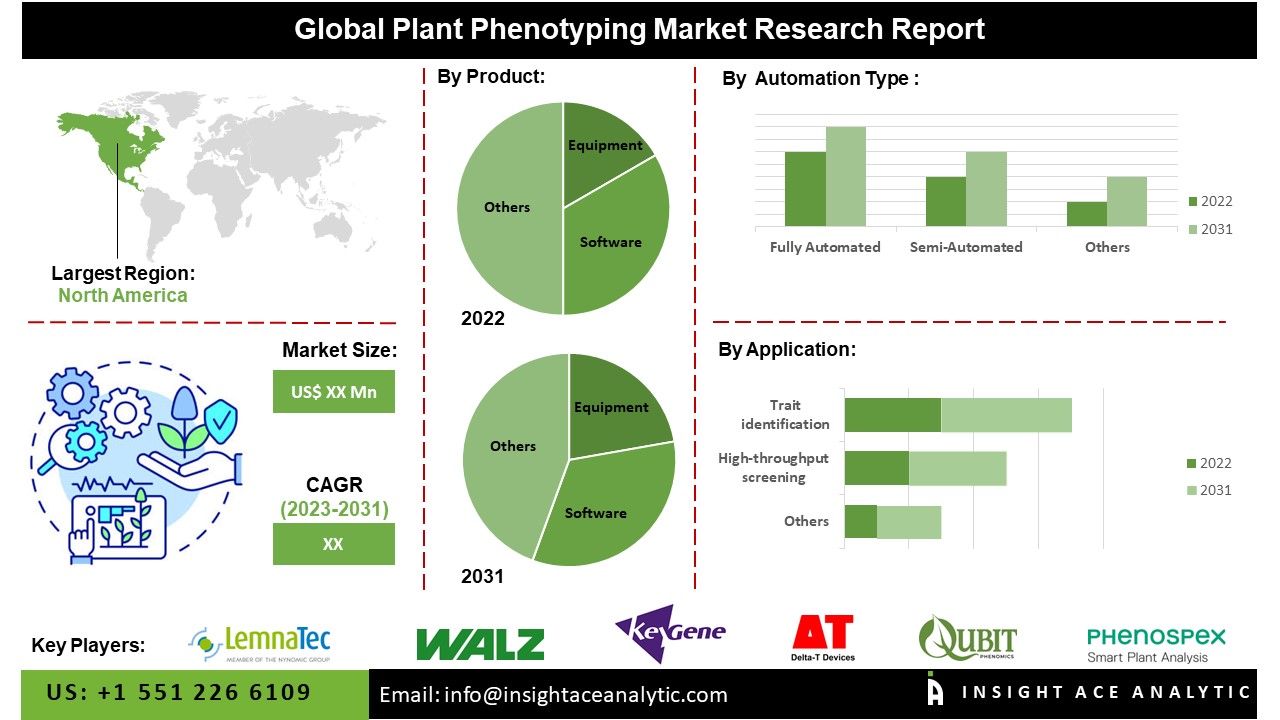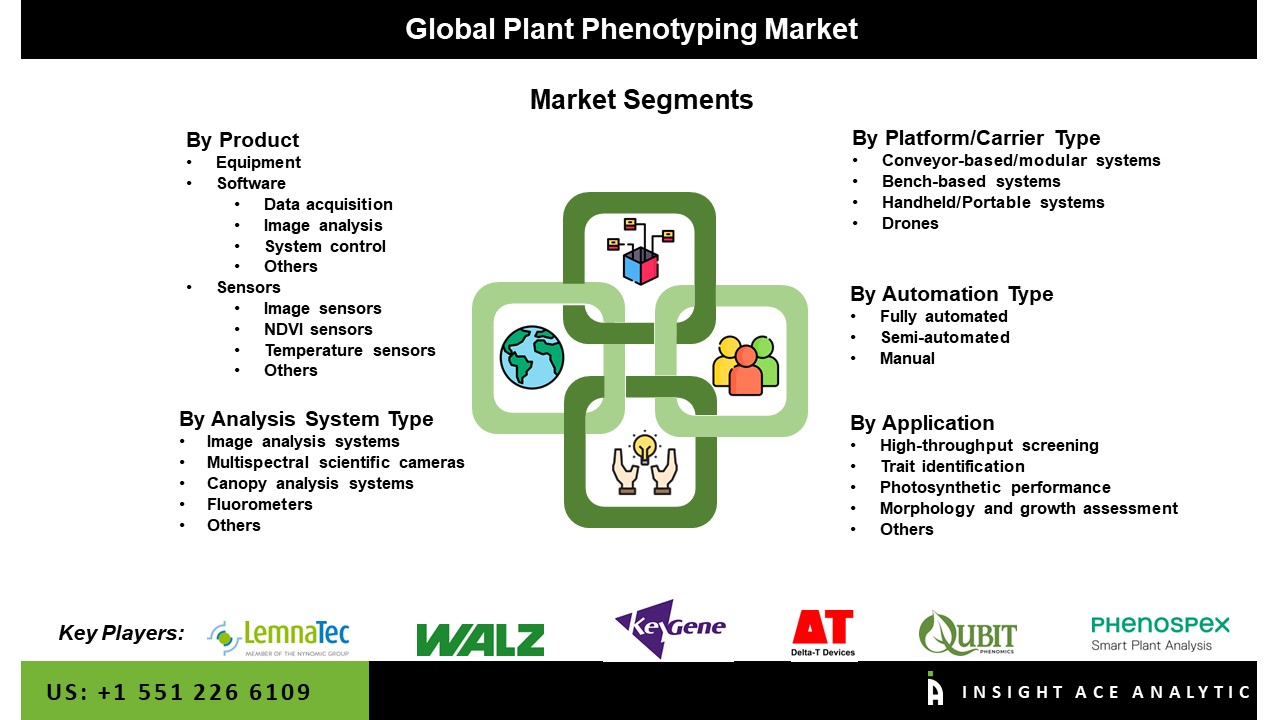The Global Plant Phenotyping Market Size is valued at 236.13 million in 2022 and is predicted to reach 640.89 million by the year 2031 at a 11.93% CAGR during the forecast period for 2023-2031.
The need for high-yielding crops to meet food security requirements has been driven by the growing population, which is, in turn, driving demand for novel plant breeding strategies to increase crop productivity. Global warming and the augmented frequency of extreme weather events are also increasing the demand for crop yield, boosting the phenotyping market.

Additionally, improvements in imaging technology provide a better evaluation of plant traits enabling the creation of improved crop breeds fit for the specific area. By employing various technologies, such as imaging spectroscopy, infrared imaging, fluorescence imaging, and visible light imaging, whose data sorts from macroscopic to molecular scale, imaging techniques help detect optical features of plants.
Increased research and development initiatives, as well as an increasing trend of commercial plant breeders and plant-based science research organizations using plant phenotyping services, are driving market expansion.
Also, the demand for high-throughput phenotyping platforms to be used in greenhouses is a significant contributor to market expansion. Computing facilitates the creation of field-based platforms and controlled environment-based phenotyping platforms by fusing advances in aeronautics, autonomous control technology, and sensing technologies. Recent years have seen the commercial sale and implementation of controlled environment-based phenotyping technologies in greenhouses.
The plant phenotyping market is segmented based on product. Based on product, the market is segmented into Equipment, Software (Data Acquisition, Image Analysis, System Control, and Others), and Sensors (Image Sensors, NDVI Sensors, Temperature Sensors, and Others). Platform/Carrier type segment includes Conveyor-Based/Modular Systems, Bench-Based Systems, Handheld/Portable Systems, and Drones. The automation Type segment includes Fully Automated, Semi-Automated, and Manual. Analysis System Type segment includes Image Analysis Systems, Multispectral Scientific Cameras, Canopy Analysis Systems, Fluorometers, and Others. The application segment comprises High-Throughput Screening, Trait Identification, Photosynthetic Performance, Morphology and Growth Assessment.
The North American, Plant Phenotyping Market, is predicted to register the highest market share in revenue in the near future. This can be attributed to more government and industry players taking the initiative to develop new technology. The creation of associations like the North American Plant Phenotyping Network (NAPPN), a group of researchers and scientists seeking to accelerate research and development, is one of these initiatives. Europe started the European Plant Phenotyping Project (EPPN) to build a phenotyping infrastructure in the area. The network consists of initiatives including the UK Plant Phenomics Network, the French Plant Phenotyping Network (FPPN), the International Plant Phenotyping Network (IPPN), and the Deutsches Pflanzen Phänotypisierungs Netzwerk (DPPN).
| Report Attribute | Specifications |
| Market size value in 2022 | USD 236.13 Mn |
| Revenue forecast in 2031 | USD 640.89 Mn |
| Growth rate CAGR | CAGR of 11.93 % from 2023 to 2031 |
| Quantitative units | Representation of revenue in US$ Billion, and CAGR from 2023 to 2031 |
| Historic Year | 2019 to 2022 |
| Forecast Year | 2023-2031 |
| Report coverage | The forecast of revenue, the position of the company, the competitive market statistics, growth prospects, and trends |
| Segments covered | Products, Platform, Automation Type, Analysis System Type And Application |
| Regional scope | North America; Europe; Asia Pacific; Latin America; Middle East & Africa |
| Country scope | U.S.; Canada; U.K.; Germany; China; India; Japan; Brazil; Mexico; The UK; France; Italy; Spain; China; Japan; India; South Korea; Southeast Asia; South Korea; Southeast Asia |
| Competitive Landscape | Lemnatec (Nynomic Ag), Delta-T Devices Ltd., Heinz Walz Gmbh, Phenospex, Keygene, Phenomix, Cropdesign, Qubit Systems Inc., Photon Systems Instruments, Wps B.V., Wiwam, Rothamsted Research Limited, Vbcf, Plant Ditech, Bex, Co. Ltd. |
| Customization scope | Free customization report with the procurement of the report, Modifications to the regional and segment scope. Particular Geographic competitive landscape. |
| Pricing and available payment methods | Explore pricing alternatives that are customized to your particular study requirements. |
Plant Phenotyping Market By Product-

Plant Phenotyping Market By Platform/Carrier Type:
Plant Phenotyping Market By Automation Type:
Plant Phenotyping Market By Analysis System Type:
Plant Phenotyping Market By Application:
Plant Phenotyping Market By Region-
North America-
Europe-
Asia-Pacific-
Latin America-
Middle East & Africa-
Chapter 1. Methodology and Scope
1.1. Research Methodology
1.2. Research Scope & Assumptions
Chapter 2. Executive Summary
Chapter 3. Global Plant Phenotyping Market Snapshot
Chapter 4. Global Plant Phenotyping Market Variables, Trends & Scope
4.1. Market Segmentation & Scope
4.2. Drivers
4.3. Challenges
4.4. Trends
4.5. Investment and Funding Analysis
4.6. Industry Analysis – Porter’s Five Forces Analysis
4.7. Competitive Landscape & Market Share Analysis
4.8. Impact of Covid-19 Analysis
Chapter 5. Market Segmentation 1: by Product Type Estimates & Trend Analysis
5.1. by Product Type & Market Share, 2019 & 2031
5.2. Market Size (Value (US$ Mn)) & Forecasts and Trend Analyses, 2019 to 2031 for the following by Product Type:
5.2.1. Equipment
5.2.2. Software
5.2.2.1. Data acquisition
5.2.2.2. Image analysis
5.2.2.3. System control
5.2.2.4. Others
5.2.3. Sensors
5.2.3.1. Image sensors
5.2.3.2. NDVI sensors
5.2.3.3. Temperature sensors
5.2.3.4. Others
Chapter 6. Market Segmentation 2: by Platform/Carrier Type Estimates & Trend Analysis
6.1. by Platform/Carrier Type & Market Share, 2019 & 2031
6.2. Market Size (Value (US$ Mn)) & Forecasts and Trend Analyses, 2019 to 2031 for the following by Platform/Carrier Type:
6.2.1. Conveyor-based/modular systems
6.2.2. Bench-based systems
6.2.3. Handheld/Portable systems
6.2.4. Drones
Chapter 7. Market Segmentation 3: by Automation Type Estimates & Trend Analysis
7.1. by Automation Type & Market Share, 2019 & 2031
7.2. Market Size (Value (US$ Mn)) & Forecasts and Trend Analyses, 2019 to 2031 for the following by Automation Type:
7.2.1. Fully automated
7.2.2. Semi-automated
7.2.3. Manual
Chapter 8. Market Segmentation 4: by Analysis System Type Estimates & Trend Analysis
8.1. by Analysis System Type & Market Share, 2019 & 2031
8.2. Market Size (Value (US$ Mn)) & Forecasts and Trend Analyses, 2019 to 2031 for the following by Analysis System Type:
8.2.1. Image analysis systems
8.2.2. Multispectral scientific cameras
8.2.3. Canopy analysis systems
8.2.4. Fluorometers
8.2.5. Others
Chapter 9. Market Segmentation 5: by Application Estimates & Trend Analysis
9.1. by Application & Market Share, 2019 & 2031
9.2. Market Size (Value (US$ Mn)) & Forecasts and Trend Analyses, 2019 to 2031 for the following by Application:
9.2.1. High-throughput screening
9.2.2. Trait identification
9.2.3. Photosynthetic performance
9.2.4. Morphology and growth assessment
9.2.5. Others
Chapter 10. Plant Phenotyping Market Segmentation 6: Regional Estimates & Trend Analysis
10.1. North America
10.1.1. North America Plant Phenotyping Market Revenue (US$ Million) Estimates and Forecasts by Product Type, 2023-2031
10.1.2. North America Plant Phenotyping Market Revenue (US$ Million) Estimates and Forecasts by Platform/Carrier Type, 2023-2031
10.1.3. North America Plant Phenotyping Market revenue (US$ Million) by Automation Type, 2023-2031
10.1.4. North America Plant Phenotyping Market revenue (US$ Million) by Analysis System Type, 2023-2031
10.1.5. North America Plant Phenotyping Market revenue (US$ Million) by Application, 2023-2031
10.1.6. North America Plant Phenotyping Market Revenue (US$ Million) Estimates and Forecasts by country, 2023-2031
10.2. Europe
10.2.1. Europe Plant Phenotyping Market revenue (US$ Million) by Product Type, 2023-2031
10.2.2. Europe Plant Phenotyping Market revenue (US$ Million) by Platform/Carrier Type, 2023-2031
10.2.3. Europe Plant Phenotyping Market revenue (US$ Million) by Automation Type, 2023-2031
10.2.4. Europe Plant Phenotyping Market revenue (US$ Million) by Analysis System Type, 2023-2031
10.2.5. Europe Plant Phenotyping Market revenue (US$ Million) by Application, 2023-2031
10.2.6. Europe Plant Phenotyping Market revenue (US$ Million) by country, 2023-2031
10.3. Asia Pacific
10.3.1. Asia Pacific Plant Phenotyping Market revenue (US$ Million) by Product Type, 2023-2031
10.3.2. Asia Pacific Plant Phenotyping Market revenue (US$ Million) by Platform/Carrier Type, 2023-2031
10.3.3. Asia-Pacific Plant Phenotyping Market revenue (US$ Million) by Automation Type, 2023-2031
10.3.4. Asia Pacific Plant Phenotyping Market revenue (US$ Million) by Analysis System Type, 2023-2031
10.3.5. Asia Pacific Plant Phenotyping Market revenue (US$ Million) by Application, 2023-2031
10.3.6. Asia Pacific Plant Phenotyping Market revenue (US$ Million) by country, 2023-2031
10.4. Latin America
10.4.1. Latin America Plant Phenotyping Market revenue (US$ Million) by Product Type, 2023-2031
10.4.2. Latin America Plant Phenotyping Market revenue (US$ Million) by Platform/Carrier Type, 2023-2031
10.4.3. Latin America Plant Phenotyping Market revenue (US$ Million) by Automation Type, 2023-2031
10.4.4. Latin America Plant Phenotyping Market revenue (US$ Million) by Analysis System Type, 2023-2031
10.4.5. Latin America Plant Phenotyping Market revenue (US$ Million) by Application, 2023-2031
10.4.6. Latin America Plant Phenotyping Market revenue (US$ Million) by country, 2023-2031
10.5. Middle East & Africa
10.5.1. Middle East & Africa Plant Phenotyping Market revenue (US$ Million) by Product Type, 2023-2031
10.5.2. Middle East & Africa Plant Phenotyping Market revenue (US$ Million) by Platform/Carrier Type, 2023-2031
10.5.3. Middle East & Africa Plant Phenotyping Market revenue (US$ Million) by Automation Type, 2023-2031
10.5.4. Middle East & Africa Plant Phenotyping Market revenue (US$ Million) by Analysis System Type, 2023-2031
10.5.5. Middle East & Africa Plant Phenotyping Market revenue (US$ Million) by Application, 2023-2031
10.5.6. Middle East & Africa Plant Phenotyping Market revenue (US$ Million) by country, 2023-2031
Chapter 11. Competitive Landscape
11.1. Major Mergers and Acquisitions/Strategic Alliances
11.2. Company Profiles
11.2.1. BASF SE
11.2.2. Cropdesign
11.2.3. Delta-T Devises Ltd.
11.2.4. Heinz Walz Gmbh
11.2.5. Hiphen
11.2.6. Keygene N.V.
11.2.7. Lemnatec (Nynomic Ag)
11.2.8. Phenomix
11.2.9. Photon Systems Instruments
11.2.10. Bex, Co. Ltd.
11.2.11. Plant-DiTech
11.2.12. Qubit Systems Inc.
11.2.13. Rothamsted Research Limited
11.2.14. Vienna BioCenter Core Facilities
11.2.15. WIWAM
11.2.16. WPS B.V.
11.2.17. Other Prominent Players